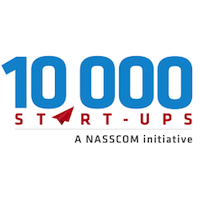
Nasscom 10 000 Start-ups
View Brand PublisherWithin five months of launching two IoT-powered solutions, HAL Robotics is gaining good traction from Indian enterprises. Here’s why
In this age of IoT-driven everything, it was only time before somebody came up with a solution that would draw from the popular Hindi adage doodh ka doodh, pani ka pani.
For ages, the neighbourhood milkman’s adulteration of milk has been one of the worst-kept secrets being tolerated by his customers. But what if the branded milk with quality assurance from your trusted dairy is being adulterated as well? As a consumer, you would consider it a serious breach of trust, and it’s also a serious legal offence.
A renowned dairy company faced this problem. It found that the quality of milk at the procurement centres was far superior to the quality of the same milk by the time it reached the chilling and production centres. In spite of using dedicated chilling tankers for transit, the milk was being adulterated with untreated water, foreign proteins, whey proteins, melamine and urea, vegetable or animal fats, plus many minor constituents of milk. And, to counter the effect of adulteration, the dairy companies are compelled to treat the milk with antibiotics, which can have negative impact on consumers health.
Even though the company used traditional preventive measures such as seals and locks to stop the pilferage, but it could not bring down the instances of adulteration. Running out of options, the dairy company reached out to HAL Robotics for an IoT-based solution to address the challenge.
Today, the instances of adulteration have reduced drastically. This is due to a fleet management solution that uses the startup’s flagship device called ‘ROBO’ mounted on the tankers, which predicts anomalies in vehicle movement pattern, records unusual halts as well as updates the performance ranking of vehicles and driving behaviour in the same route. This makes it easier to monitor any changes in the transit plan. In addition, a hardware product called ROBO Lock has been installed in the tanker’s inlets and outlets. The device creates geo fences which permits the locking and unlocking of the inlets and outlets at predetermined locations, and if someone tries to forcefully open these at any other destination or during transit, alerts will be sent to the stakeholder along with information about the location.
Fusing IoT and AI to solve enterprises’ real world problems
It is these kind of real world problems faced by enterprises that Gurgaon-based HAL Robotics addresses with their homegrown AI-powered IoT data platform, interwoven with custom-designed special purpose hardware sensors. Started in October 2016 by Prabhakar Chaudhary, Bijender Singh and Abhijit Borgohain, HAL Robotics is today a 15-member strong team with hardware and software engineers, data scientists, and sales and operations personnel.

Prabhakar Chaudhary, Co-founder and Managing Director, says, “Technology firms are either hardware focused or software focused. Few are into only data analytics. Today, customers want an end-to-end vertical-centric product from a single business, because it helps in better integration at all layers. We are positioned strategically with our unique capabilities to deliver end-to-end IoT-based solutions powered with AI (sensors to applications) to solve some of the perennial problems various industries have faced over the years.”
Prabhakar comes with over 15 years of experience in advisory and management roles in IT and Data Science, and has worked in companies like TCS, Intersoft, and Transorg-Analyics. Giving an insight into why HAL Robotics has been able to gain industry acceptance for two of its key products within months of them being launched, he says, “Traditionally, enterprises have been corroded off their investments due to complicated infrastructural deployment and inflated deployment costs. To address these pain points, we have redesigned modular sensors and data platforms from the ground-up. Responding to unique use-cases and operating matrices of different businesses, HAL Robotics custom designs sensors that suit an enterprise’s business needs. The products and solutions seamlessly interweave our custom-designed plug-and-play sensors, various wireless protocols and AI-powered IoT data platform. We enable enterprises to utilise smaller and radically cost-effective sensors that are extremely affordable with a pay-as-you-use model, thereby bringing in the cost affordability angle as well.”
Home-grown products that are one-of-a-kind
Using a combination of sensors, actuators and Gateway, HAL Robotics spins various solutions known as widgets. Their two key plug-and-play widgets are RoboTrack and RoboTemp. RoboTrack is a shipment monitoring system to manage task force, locate shipments, track deliveries for even the smallest of items. The solution is directed towards accurately predicting events, and demanding human intervention in case of serious glitches. Launched in November 2017, RoboTrack is already being adopted for use cases such as monitoring the supply chain of poultry and dairy products, pharma and life sciences as well as a managing the inward inventory supply chain in manufacturing companies.

The second widget, RoboTemp, is a real-time environment monitoring solution launched in January 2018. It not only helps to save energy but also issue alerts in case of unusual temperature fluctuations which can be detrimental to the asset. RoboTemp is being used by organisations that deal with poultry, dairy, FMCGs, and perishable goods such as fruits and vegetables.
The USP of RoboTrack and RoboTemp comes from their four tech stack components - ROBO, SNITCH, NEO, and the app which have been designed and built in-house. The four components are closely integrated, making the solutions efficient, predictive and sturdy.
ROBO is their 2-way IoT gateway, which communicates with their in-house sensors (SNITCH and NEO). ROBO is equipped to handle multilayer exceptions and failovers. SNITCH is a unidirectional sensor which can be put to use to monitor health and environment of any asset. NEO is a bi-directional sensor cum actuator which can be put to use to monitor and manage health and surrounding environment of any asset. “Our sensors, actuators and gateway solution, when blended with an AI-powered decision engine, bring froth a new paradigm for multistack computing by distributing intelligence across every layer of the tech stack,” says Prabhakar.
Finding industry acceptance
Since the launch of the plug-and-play widgets in the market in November 2017, HAL Robotics has onboarded five customers, which are Fortune 500 companies, and are running eight proofs of concepts. The startup’s solutions have being used for monitoring the health and environment in several instances: while transporting drugs and vaccines for a large pharma logistics provider, during transit of human organs for transplant and the sensitive process of end-to-end incubation of chicks in hatcheries. It has also been used to securely lock containers and issue real-time alerts in case of tampering. In a span of just five months, the startup has deployed close to 200+ gateway devices.
While their product and solutions have been their biggest strength that has helped them gain customers, the Managing Director says that their association with NASSCOM 10,000 Startups has been vital in getting access to early customers. “Customers opened their doors because of NASSCOM’s recommendation. We have been working closely with Dr. Sunil K. Shekhawat, who is the Regional Lead ( North ) at NASSCOM 10,000 Startups. Sunil provided us multiple platforms and industry connect sessions which helped us get our early customers. It’s almost as if NASSCOM 10,000 Startups was part of our co-founding team. For an early stage startup like us, an industry body like NASSCOM trusting us meant we were able to build customer connects far more easily than we would have been able to on our own.” Prabhakar believes that in addition to NASSCOM 10,000 Startups’ support and the positive industry response, their biggest confidence has come from customer appreciation.
HAL Robotics has been bootstrapped so far, but is now actively looking to get funded to speed up their business growth and expand their product portfolio. Prabhakar says, “We were very clear that we will go for funding only after on boarding the first few paying customers. We knew that we had a good product at hand, but we wanted to show the viability of our product and business potential to win investors’ confidence.”
Talking about the product and growth roadmap he says, “Real-time business metrics monitoring can be applied in any industry vertical which eventually makes the market size limitless. However, separate widgets would be built for vertical solutions in a given industry. Currently we have only two widgets and intend to build significant revenue with these two, before foraying into more solutions and industries. We aim to generate an annual revenue of USD 4-5 million in FY2018-19.”
Today, their home-grown hardware and software platform is one of their biggest growth drivers. But it was also one of their biggest challenges during their product development journey. “We tried working with off-the-shelf sensors, but weren’t able to push intelligence onto the edge devices. The decision to build our own hardware was a tough call and our journey of hardware design was full of challenges. We failed and tried multiple times, before finally being able to pull through it. Today, we take great pride in our product, which is designed to work on very low power, and equipped to handle multi-layer exceptions and failures. In addition, our sensors are easy to deploy, have a long battery life of up to two years, even after which the cost of replacing the battery is low. More importantly, the on-ground workforce who are the actual users of the technology do not need extensive training for deployment.”
Being part of a young product company in India, Prabhakar believes that Indian enterprises are welcoming early stage startups with proofs of concept. “Getting an appointment and customers’ attentions has never been a challenge. India is changing. And if our pace of innovation remains what it is today, India will outshine others in innovation.”







